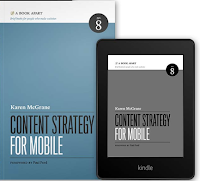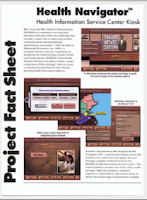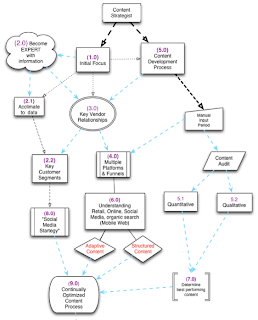Mobile Web, Part II.
 Sunday, April 28, 2013 at 08:07PM
Sunday, April 28, 2013 at 08:07PM Mobile Web, Part II
 |
| [ Figure 1 ] |
• Re-usable
• Structured
• Presentation-independent
• Metadata is meaningful
• Interface has usable CMS (Content Management Systems)1
 |
| [ Figure 2 ] |
But things changed. And we began to think about content differently. If we only knew then what we know now. Hmmm? We began to think about content as something that goes in some place. But as Karen McGrane says we have to think about it differently, or "... the most fundamental challenge is a change in (our) mindset.2
Structured content to me is a misnomer because as Rachel Lovinger, Content Strategy Director for Razorfish, says, "The more structure you put into content the freer it will become."3 And this is all about database work and activity, similar to how we housed our content for The Health Navigator for BCBSMA — one place many uses.
We now have to think about content as "chunks of information" or content modeling, which is the "...process of defining what your content is and how to chunk it up into your database."4
To me, among all of these elements of adaptive content — this is one of the most critical. It's how you think about your content in terms of "process" —or how is it going to deliver to the channel/device. McGrane says, "With adaptive content, your goal is to create a flexible base of content with a variety of structured content objects to cover a wide range of uses and contexts."5
All of this discussion is about how content needs to "morph" itself depending upon the "request" that is being made of it, or as McGrane says that creative responsive content
( through responsive web development ) "automagically" re-formats itself to channels/devices/bandwidths/platforms. 6
Presentation-Independent content (PIC) is an enigma to me. I honestly had difficulty understanding its place as one of these elements. And that is mainly because it feels like PIC is all about general web practices that we are all faced with when programming a site, or:
• platform variability
• device requirements
• user interface variance (mac vs. pc)
• layout
• animation
• formatting
And so we need to think about this — separating the content from its "presentation." McGrane calls this "separation of content from form," and she quotes information architect, Rick Yagodich, who says perfectly:
If an element of content is to be reusable — say rendered onto a website, into a print publication, through a mobile app, accessed via an API feed — it must exist in a form other than pre-formatted HTML. The element needs to be clean, a self-contained value." 7
Oh! Yah!
Meaningful metadata has gotten a bad rep because, let's face it — it's definition is kind of redundant — or, metadata is the data of data. And very honestly, it is critical to adaptive content because the types of metadata that you create for this need is specific to the various elements of adaptive content. Ok, what the hell does that mean?- Creating specific metadata for content re-use allows you to target individual content to different platforms so each platform knows what to do.
- "When we talk about content models, content packages and content chunks (structured content) — we're really talking about metadata."
- PIC states that "we need to develop ways to encode...meaning in ...content — through metadata that tells us what the content means, not just how it should look. [ all 3 bullet points, 8 ]
Usable CMS is a difficult subject matter to summarize, and McGrane says it all with this:
"A good user experience in a CMS depends on having a well-defined authoring and publishing workflow."9 A workflow must include standards and guidelines, particularly if there are none in place before you get there. Because of the fact that CMS itself is very different from one version
to another — I am going to limit my summary about this in this blog. Please see and read McGrane's expert summary about this. Buy the book.
(I get no kickback from this.)
There's much more to come in Content Strategy, Part III.
Stay tuned to the station.
--------------------------------------------------------------------------------------------------------
1 "Content Strategy for Mobile," Karen McGrane, A Book Apart, 2012, page 53.
2 Ibid, page 54.
3 Ibid, page 58.
4 Ibid. page 59.
5 Ibid. page 64.
6 Ibid. page 65.
7 Ibid. page 67.
8 Ibid. page 74.
9 Ibid, page 75.
